This step by step diy woodworking project is about a 12×16 backyard pavilion plans. I have designed this pavilion, so you can create a nice shelter in your own backyard. The frame of the pavilion is built from 6×6 beams, so you can create a sturdy structure. the roof has a 45 degree slope for draining the water and snow easily. Take a look over the rest of our woodworking plans, if you want to get more building inspiration.
When buying the lumber, you should select the planks with great care, making sure they are straight and without any visible flaws (cracks, knots, twists, decay). Investing in cedar or other weather resistant lumber is a good idea, as it will pay off on the long run. Use a spirit level to plumb and align the components, before inserting the galvanized screws, otherwise the project won’t have a symmetrical look. If you have all the materials and tools required for the project, you could get the job done in about a day. See all my Premium Plans HERE.
Projects made from these plans
12×16 Pavilion Plans
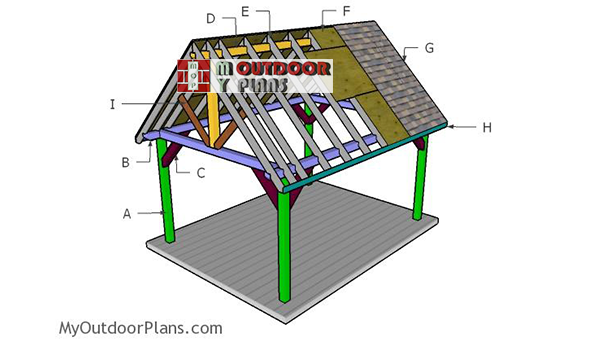
Building-a-12×16-pavilion
Cut & Shopping Lists
- A – 4 pieces of 6×6 lumber – 96″ long POSTS
- B – 2 pieces of 6×6 lumber – 144″ long, 2 pieces – 216″ long TOP PLATES
- C – 2 pieces of 6×6 lumber – 48″ long, 8 pieces – 36″ long BRACES
- D – 2 pieces of 6×6 lumber – 64 1/2″ long, 1 piece – 216″ long TOP RIDGE
- 5 pieces of 6×6 lumber – 8′
- 3 pieces of 6×6 lumber – 18′
- 2 pieces of 6×6 lumber – 12′
- 4 pieces of 6×6 lumber – 6′
- concrete form tube
- post anchors
- beam to post connectors
- structural screws for connectors
- strong tie T
- 5 1/2″ screws, 3 1/2″ screws
- wood glue, stain/paint
Tools
![]() Hammer, Tape measure, Framing square, Level
Hammer, Tape measure, Framing square, Level
![]() Miter saw, Drill machinery, Screwdriver, Sander
Miter saw, Drill machinery, Screwdriver, Sander
Time
Related
- PART 1: 12×16 Pavilion Plans
- PART 2: 12x16 Pavilion Roof Plans
How to build a 12×16 pavilion
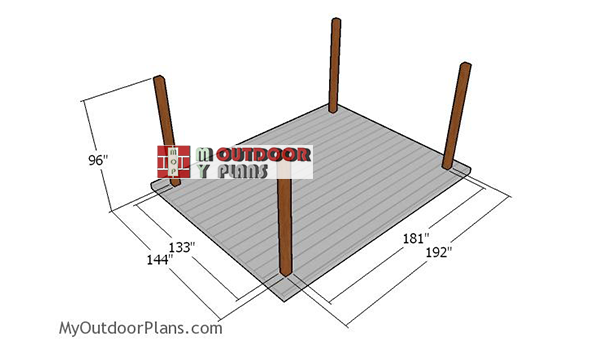
Laying-out-the-posts-for-pavilion
The first step of the project is to layout the posts for the 12×16 pavilion. Use batter boards and string to determine the location of the posts. Apply the 3-4-5 rule to every corner of the pavilion, so you make sure they are right angled. Moreover measure the diagonals and make sure they are equal.
Determining the location for the pavilion is essential, as you have to comply with the local building codes. Make sure the surface is level and remove the vegetation layer. You can pour the footings and then the slab, or you could fit the posts into concrete and then lay the concrete slab.
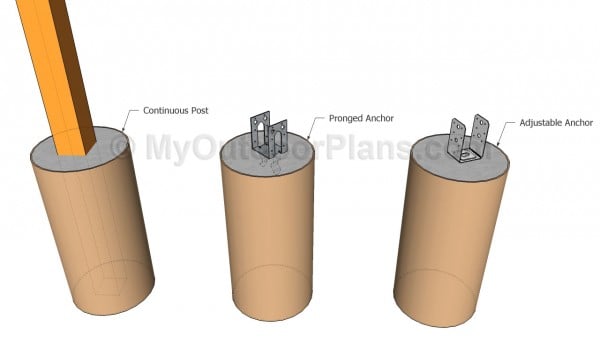
Anchoring the posts of the anchor
There are several ways to lock the posts into place. Therefore, you could dig 2-3′ holes in the ground and set the posts into concrete, or you could use post anchors. Use tube forms so that the footing will be really strong.
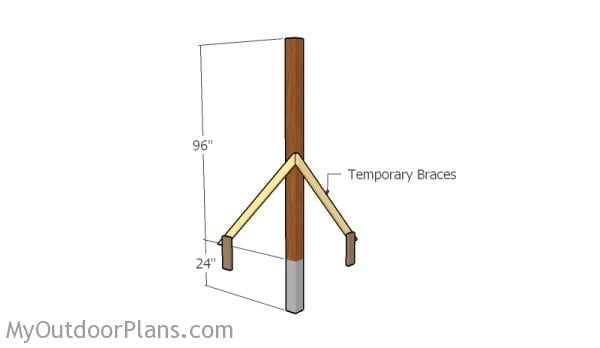
Fitting the posts
If you want to set the posts in concrete, then you need to use temporarily braces. Plumb the posts with a spirit level. Read the local building codes for finding the right depth of the footings. It is essential to set the footing at the right depth to avoid them being heaved by the Winter freeze/thaw cycle.
If you go for footings, you have to dig holes with a 14″ diameter. After digging the holes set the concrete forms and then fill them with concrete. Fit the anchors and align them with attention. After the concrete dries, fit the 6×6 posts and plumb them.
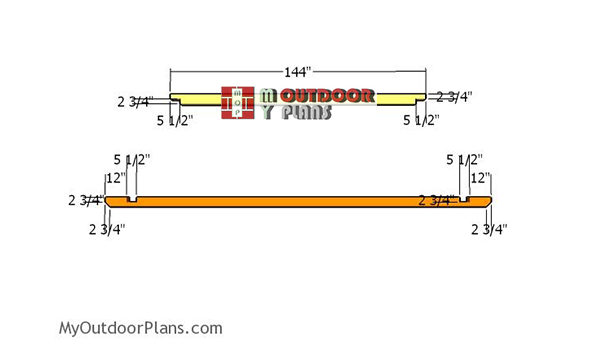
Building-the-top-rails
Use 6×6 lumber for the top rails. As you can easily notice in the diagram, you need to make notches to the top rails. Mark the areas and then use a circular saw to make parallel cuts. Remove the excess materials with a chisel and then smooth the recess with sandpaper. The long side rails are 216″ long (18′).
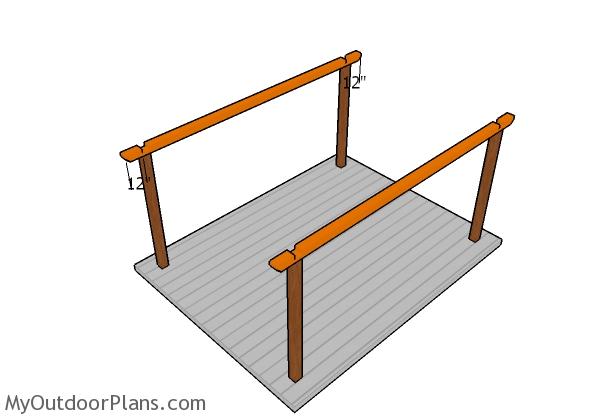
Fitting the side rails
Fit the side rails to the top of the posts. Make sure you align the edges flush and leave 12″ overhangs on both sides. Check if the corners are square and then drill pilot holes through the notches and insert 5 1/2″ screws, to secure the rails into place tightly.
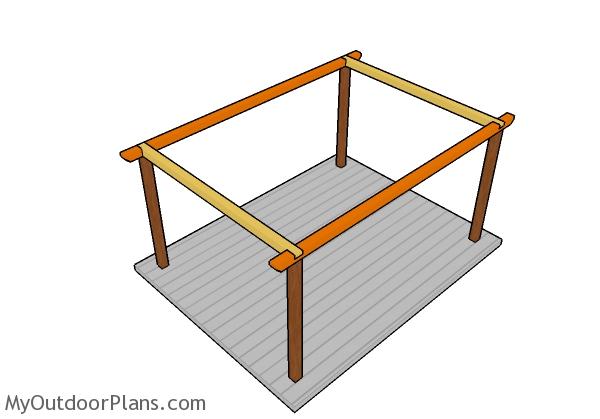
Fitting the rails
Fit the front and back rails to the top of the frame. Align the edges with attention, making sure the corners are square. Drill pilot holes and insert 5 1/2″ screws to lock them together tightly.
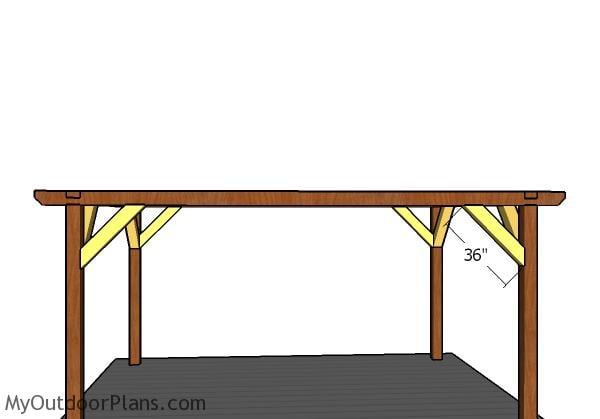
Fitting the frame braces
Use 6×6 lumber for the frame braces. If you live in a windy area, these braces will add plenty of support to the frame, so you can create a sturdy and durable structure. Cut both ends of the 45 degrees and then secure them into place with 3 1/2″ screws.
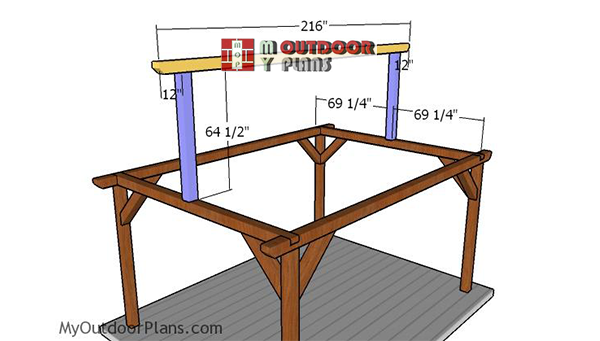
Fitting-the-top-ridge-beam
Use 6×6 lumber for the top ridge and for its supports. Cut the beams at the right dimensions and then smooth the edges with sandpaper. Center the supports to the front and back top plates and then plumb them with a spirit level. Use hardware to secure the supports into place tightly.
Center the top ridge to the top of the supports and then lock it into place with screws or metal lumber connectors. As you can see in the plans, you should make 45 decorative cuts to both ends of the top ridge beam.
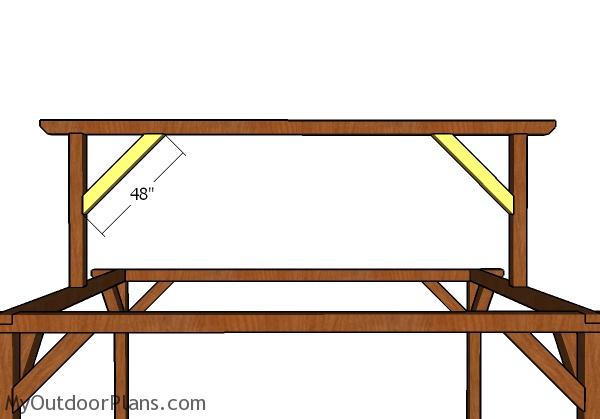
Fitting the braces
Fit the 6×6 braces to the top ridge of the outdoor pavilion. Make 45 degree cuts at both ends of the braces and then fit them to the supports and to the top ridge, as shown in the diagram. Use a spirit level to check if the supports are plumb and if the top ridge is horizontal. Drill pilot holes and insert 3 1/2″ screws to secure the braces into place tightly.
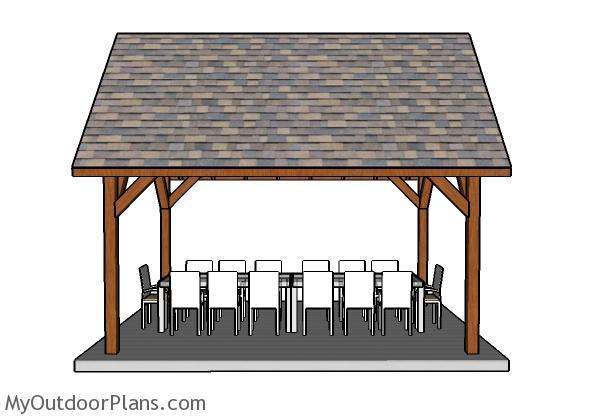
12×16 Pavilion Plans – Side View
Last, but not least, you need to take care of the finishing touches. Fill the holes with wood putty and then smooth the surface with sandpaper. Apply a few coats of paint or stain to enhance the look of the pavilion and to protect the components from decay.
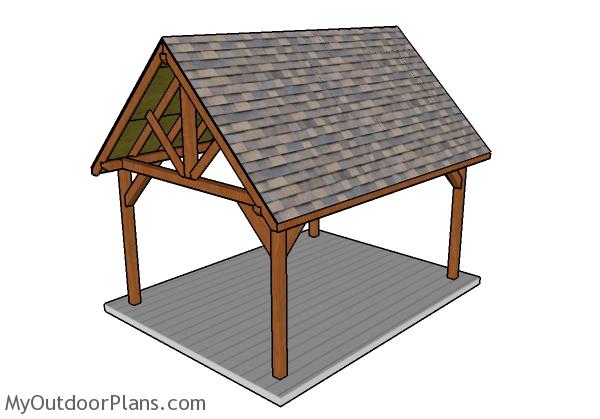
12×16 Pavilion Plans
You need to take a look over PART 2 of the project, where I show you how to frame the roof for this 12×16 pavilion.
If you want to get PREMIUM PLANS for this project (different design with re-engineered structure), in a PDF format, please press GET PDF PLANS button bellow. Thank you for the support.
This woodworking project was about 12×16 outdoor pavilion plans free. If you want to see more outdoor plans, check out the rest of our step by step projects and follow the instructions to obtain a professional result.



10 comments
Would you have a plan like this 12 x 16 where the roof isn’t as steep/tall? Maybe even 10 x 16 with roof not as steep/tall.
Thanks
Vince Daily
I have plans for a 12×14: http://myoutdoorplans.com/pergola/12×14-outdoor-shelter-plans/
Would using 8×8 beams change anything?
Yes, the 8x8s being thicker, the distance between the components will be smaller.
Would you have plans for 12×16 four hip roof? Thx up front.
No, I don’t have that now.
Hello. My name is Walter and I’m looking at your 12X16 pavilion plan. I’m adapting this plan into a covered deck. I’m using the same roof pitch. Will this roof support a 30 lb. snow load and 115 mph wind speed? My local code inspector was asking. I’ve added a post in the middle of the long side so I’m guessing it should.
By the way I enjoy looking through your plans. They’ve inspired me to do some projects around my home so thank you.
If you added middle posts along the 16 ft sides, you can as well add a crass plate that joins them together, then a support for the ridge beam with 2 nice braces. Use hurricane ties and lock everything together with nice long screws. That should do the trick for your high winds.
Hello. My name is Scott and I am looking at your 12×16 pavilion plan. I am adapting this plan into a covered deck that will be attached to the back of my house. The pavilion will remain independently supported on 4 foundations as shown in your plans. I would like to keep the foundations on the 12’ side, the side that will be placed closest to the house, 2’ away from the house foundation. Doing this will create a 2’ overhang of the side rails on that side of the pavilion. . Will this 2’ overhang be acceptable vs the 1’ overhang that is shown in the design?
Thank you!
I love this plan and have adapted it to have a 6/12 pitch roof. That was simple. I intend to build this with western Cedar, But everywhere I look it’s showing that if I go 16’ with a 6×6 I’m going to have sagging. Have you found this to be a problem, and if so do you think sealing the 2 18ft 6×6 with 6×10’s would be over kill.
Thanks in advance.